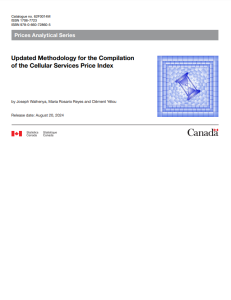 Effective with the release of the August 2024 Consumer Price Index (CPI), Statistics Canada is enhancing the way it calculates the cellular services price index.
Effective with the release of the August 2024 Consumer Price Index (CPI), Statistics Canada is enhancing the way it calculates the cellular services price index.
Each month, I examine the telecommunications-related components of the CPI, and I frequently refer to the results on these pages (such as here or here) or on social media.
Last month, Statistics Canada’s CPI release included a notice of an “upcoming enhancement”. The technical note, available in HTML or pdf formats, contains a lot of statistical jargon that reminded me of my graduate school days.
But there is a lot of summary information that everyone can understand. Bottom line? Statistics Canada is getting information on actual sales to calculate the cellular services component of the Consumer Price Index.
The Consumer Price Index (CPI) measures price change by comparing the cost of a fixed basket of consumer goods and services through time. To produce a CPI that accurately reflects the experience of Canadians, Statistics Canada regularly updates the methodologies of various components of the CPI. The method used to calculate the CPI follows accepted international standards. It is also regularly reviewed internally and by experts outside the agency, and adjusted as needed to ensure it meets best practices.
Effective with the August 2024 release, “Statistics Canada now receives monthly transaction data containing plan level information from WSPs with several retail brands across Canada.” The transaction data provides a more comprehensive source of information used to enhance the index than the previous methods of data collection, and Statistics Canada says it represents a “more complete picture of the market.”
There is a cautionary “however” attached to the enhancements.
This enhancement improves the quality of the data, while ensuring the representativeness of prices paid by Canadian consumers. Users should exercise caution when interpreting the year-over-year change for the first 12 months following the implementation of a new methodology and data source.
Users are also advised to exercise caution when making provincial/territorial comparisons. The market shares of the sampled wireless service providers vary across provinces and territories, and price changes derived from transaction data may differ from price changes derived from web-collected data as transaction data includes monthly charges for in-market and legacy plans, while web-collected data only contains monthly charges for advertised plans.
It bears repeating with emphasis: “Users should exercise caution when interpreting the year-over-year change for the first 12 months following the implementation of a new methodology and data source.”
I will be starting a new spreadsheet effective with tomorrow’s CPI release. Watch out for anyone citing the CPI for year-over-year changes in cellular services prices.
